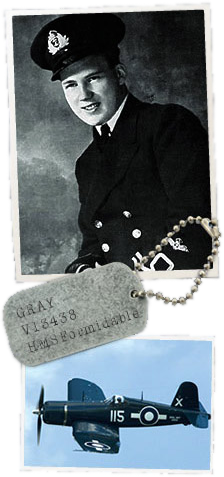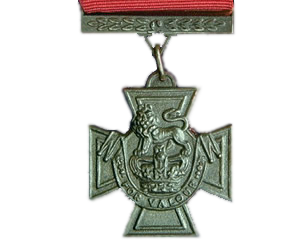Robert Gray
Military Life
In summer 1940, Gray enlisted in the Royal Canadian Naval Volunteer Reserve (RCNVR) as officer candidates. Realizing succession to higher ranks would be slow in the RCNVR, he subsequently made application to join the Royal Navy Fleet Air Arm.
By 1941, Hammy had been promoted to the rank of Sub-Lieutenant and was sent to North Africa in 1942 following further training. For the next two years, he would gain valuable experience flying Hawker Hurricanes and other of the Navy’s shore-based aircraft.
As a Lieutenant (N), Hammy’s wishes to be transferred to an operational carrier squadron were realized in August 1944 when he transferred to HMS Formidable as the Senior Pilot. Later that month Hammy would see action against the mighty German Battleship Tirpitz – sister ship to the Bismarck, which terrorized the North Atlantic for a brief period in May 1941. Throughout the month, Gray would be involved in four separate attacks against the Tirpitz. Hammy would be awarded with a Mentioned in Dispatches for his outstanding work during the last attack on the 29 August against the Tirpitz.
April 1945 would see HMS Formidable and Hammy being sent to join the British Pacific Fleet in their fight against the Japanese. In July of 1945, Gray led a mission strafing airfield near Tokyo and another mission which resulted in the damage of a merchant ship, two seaplane bases and an air base. He was awarded the Distinguished Service Cross for assisting in the sinking of a Japanese destroyer on 28 July.
Citation for the Distinguished Service Cross
For determination and address in air attacks on targets in Japan.
On 6 August 1945 the United States dropped an atomic bomb on the city of Hiroshima, the first of two atomic bombs against dropped on the Japanese mainland. By this time, many involved in the conflict realized that the war may soon be over. On 9 August 1945, the same day the United States dropped a second atomic bomb (this time on Nagasaki), Gray flew off the HMS Formidable, to lead an attack on Japanese shipping in Onagawa Wan (Bay) in the Island of Honshu, Mainland of Japan. At Onagawa Bay the fliers found below a number of Japanese ships and dived into attack. Furious fire was opened on the aircraft from army batteries on the ground and from warships in the Bay. Lieut. Gray selected for his target the Japanese escort ship Amakusa. He swept in oblivious of the concentrated fire and made straight for his target. His aircraft was hit and hit again, but he kept on. As he came close to the destroyer his plane caught fire but he pressed to within 50 feet of the Japanese ship and let go his bombs. He scored at least one direct hit, possibly more. The destroyer sank almost immediately. Lieutenant Gray did not return. He had given his life at the very end of his fearless bombing run.











